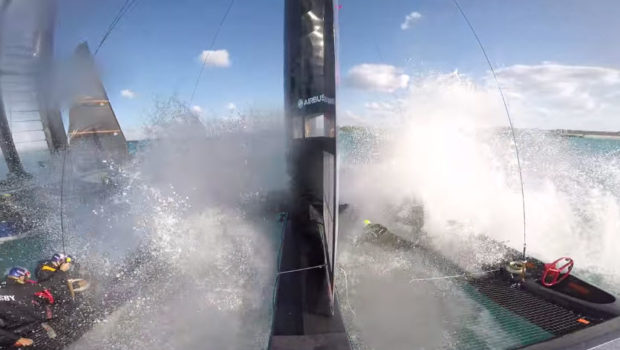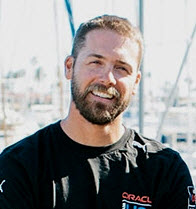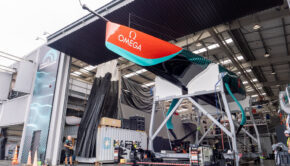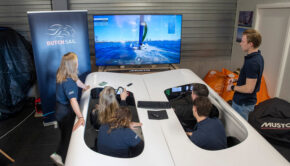America’s Cup: Yes, It’s a Little Scary
Published on July 19th, 2016
From winning the Youth Worlds to College Sailor of the Year to the Olympic Games, Andrew Campbell (USA) is now on the sailing team for America’s Cup defender ORACLE TEAM USA. Here he discusses risks and safety…
One question we get asked a lot is whether what we do is scary or if part of the sailing scares us. The first gut answer is: no not really. We do this every day, we’re accustomed to the speeds. We know the points of the race course that are dangerous and the places on the boat where you’re at risk. We try to strategically set up our sailing to minimize our time in those areas, and thereby mitigate the risks.
But on second thought, yeah… it is a little scary.
Why else would we wear helmets? Why do we wear spare air tanks? Why would we wear impact vests? Why do we wear climbing harnesses, and safety knives? Why does each team need a diver and a paramedic on the water every single day we go sailing? Why do we need to know our extraction points on shore? Our capsize protocols? Our in-the-water backboard training…? Why do we have comprehensive insurance?
When you look at it like that, the consequences of a mishap become a bit scary.
Quite often it is human error that puts us at risk, but we do sail on an experimental foiling catamaran designed and built to explore the edges of maximum speed and maneuverability. Whenever the boat goes into a bearaway, the pitch control, the grinding, wing shape and trim all need to be in sync to not only enable to boat to get down to angle successfully, quickly and efficiently from a tactical sailing point of view, but also from structure and safety point of view. The same risk is applied to each gybe, each bottom mark turn-up, while reaching, and any time we’re in close proximity to other boats.
The success of any maneuver relies on the choreography of trimming, button pushes, grinding, movement and steering. Getting out of sync can throw the moment into turmoil. Recognizing that the maneuver has gotten out of hand is one thing, but assessing what’s going wrong, communicating that problem, troubleshooting it and then taking the correct action to either save or abort the maneuver is what keeps us safe at the end of the day.
With six sailors on board the boat, you really do depend on each sailor to do his job with the strictest discipline or otherwise things can get out of hand very quickly. In a racing situation you depend on the other boats to not only act rationally and predictably from a rules and strategic point of view, but also you must plan for things to go unpredictably.
While we’re testing and training, we have the luxury of that buffer to be conservative with our positioning to allow for the small mistakes. That buffer tends to dissolve as we enter the Louis Vuitton America’s Cup World Series, just as it will come time for the America’s Cup Match.
So are these boats scary to sail? Not really. They certainly have their moments where we’re all looking around and wondering if we got away with one… but we practice like we race and when you come off the gas pedal the boat doesn’t all of a sudden get safer. In fact, as with many performance boats, speed is often your friend.
As faster sailing becomes more common, it’s so important for the management of those classes to keep the safety of their sailors and spectators at the core of any events they run. Accidents can happen at any level of the game, but planning for those accidents and mitigating the risk must be the top priority for our sport.
To assume that just because the America’s Cup has very few accidents is because we don’t sail with risk wouldn’t be accurate. Hopefully the procedures and approach to risk management taken by teams and event organizers at the top level of our sport can trickle to other areas of the game and keep us all safer in the future.
Here’s an incident when it got a little scary…










 We’ll keep your information safe.
We’ll keep your information safe.